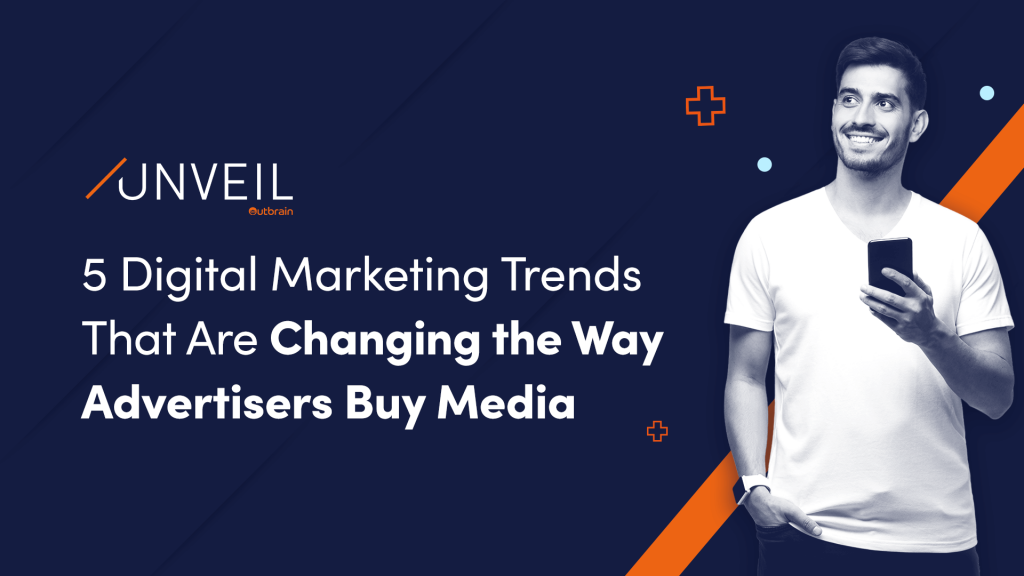
Many articles at the turn of the year focused on the impact of COVID and which of the changing consumer habits will stay with us post-pandemic. But predictions are extremely difficult in this regard, as it is not yet clear whether people will continue to shop online exclusively or rather enjoy the shopping experience in crowded city centers due to a return to normalcy.
That being said, 5 major trends are emerging that have been with us for some time now and will continue on their path regardless of current influences. Understanding these trends and aligning marketing strategy accordingly will be key to sustainable success in digital marketing (themes that we’ll be covering at our exclusive event, Outbrain Unveil!).
5 Major Digital Marketing Trends
1. The paradox of disruptive online advertising
Marketers have been working with the paradox for years: customers should ideally not be bothered with ads. Though on the other hand, the only way to create awareness is through this disruption. Native ads on Google and social networks have paved the way for a different understanding of digital marketing.
Outbrain’s Viewability study from 2019 showed that relevance and context are the most important reasons for positive reactions to ads. With overly pushy ads, marketers run the risk of evoking negative associations. In fact, native ads on Facebook or other channels are also suitable for making products known — the decisive factors here are data and algorithms that optimize for specific targets, not specific formats that are built to disrupt and enforce attention.
2. No successor for Facebook
An analysis of the click-through rate and pricing of Facebook ads over the past few years shows that the sweet spot on the platform was reached in 2016. Ads subsequently became more expensive and less frequently clicked. The reason for this is that engagement is now (also) happening elsewhere.
There is no longer just the one platform that unites all target groups. Rather, marketers need to diversify and develop tailored content and formats for numerous channels. However, fake news, conspiracy theories, and lack of moderation ensure that advertising on platforms with user-generated content remains a challenge for brands with a high demand for brand safety. Ideally, the diversification includes ads on search, social, and the open web to reach all relevant audiences.
3. Purpose marketing is a business driver
Brands like Patagonia that became billion-dollar companies with a clear stance and commitment to environmentalism are no longer exceptions. The hype around Tesla, for example, is also driven by expectations of fundamental changes in mobility and environmental protection. This will intensify in the coming years.
Bosch also recently showed the connection of two views (and generations) in a humorous commercial: product features and sustainability should not exclude each other but form a bond. Brands can no longer avoid topics such as diversity and inclusion. According to eMarketer, for 61% of customers, inclusion is a crucial factor for brand loyalty. Brands will include these progressive themes into their DNA to achieve long-term success.
4. The end of exclusive bookings
In the analog age, advertisers booked specific verticals to reach their target audience. Women could be reached through celebrity magazines, men through car magazines. That’s how simple the (clichéd) marketing world was in recent decades.
In the digital space, the use of data is making this traditional media booking more and more obsolete, but this has not yet reached all planners. With automated media booking, ads find their target audiences across the internet. Relevance to the individual user will be key.
With these new opportunities through technology comes an understanding of the diversity of interests: Why shouldn’t a top female executive be interested in sports scores or why shouldn’t a man be looking for cooking recipes? However, there will continue to be exceptions: very niche target groups, often found in the B2B sector, will continue to be addressed directly on specific platforms.
5. Endless feeds
The entire web is now organized by feeds. Not only do all social platforms rely on this user experience, but feeds, in which ads and editorial content are embedded, have also become standard in the Open Web. The goal is to give customers more choice in order to increase the time they spend on a website or platform.
Feeds are increasingly becoming the operating system of website operators — also because many users no longer reach article pages via the homepage, but directly via social or search. Presenting them with a wide range of topics is the key to efficient monetization. Within these feeds, we will see more and more new formats in the future.
More Trends? Join Us at Unveil
Regardless of current trends, these overarching developments will be with us for the foreseeable future. From corporate alignment to media booking, marketers are asked to drive this change at all levels to ensure sustainable success.
Be sure to save your seat for Unveil (register below!) to get an insider look at all of the trends for 2021, and a view of Outbrain like you’ve never seen before.